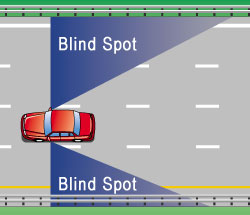A Driver’s Twilight Zone: The Blind Spot
By: Lucy Zemljic on April 30, 2014
Most people have heard the term “blind spot” enough times to know that it’s definitely something worth worrying about when you’re behind the wheel. When rolling down the highway, you might be pretty confident in your quick reflexes and rear-view mirrors, but there’s a sneaky driver’s Twilight Zone hiding from view. This is called the “blind spot,” and has been posing a threat to drivers ever since their wheels first rattled down the road.
Where Exactly is the Blind Spot?
The definition of a blind spot as it relates to driver safety is the area around the vehicle that can’t be directly observed by the driver as he or she is behind the wheel. These areas cannot be seen while looking forward, looking through the side mirrors, or through the rear-view mirror. Your blind spot is outside of your field of vision when driving, off to the side and closer to the rear of your vehicle. This is much easier to explain through a visual than through words alone, so take a look at the illustration below to get a clearer picture of where the blind spot is.

Over the past few years, many new cars have come equipped with blind-spot-eliminating technology, from the low-tech solution of improved side-view mirrors, to high-tech electronic blind spot sensors.
How to Check Your Blind Spot – The Old Fashioned Way
If you’re driving an older model, you’ll need to check your blind spot the old fashioned way. For a new driver, it may seem a bit tricky at first, but over time remembering to check your blind spot becomes second nature.
A quick “shoulder check” will allow you to see what’s going on at your vehicles’ sides – simply turn your head to the left or right, until you’re looking along your shoulder. This allows you to check if there’s a vehicle in your side gate. If you’d rather eliminate your blind spots altogether, then there’s a low-tech solution that allows you to do so, using nothing but your side-view mirrors.
Adjust those Mirrors
In order to adjust your mirrors to eliminate that blind spot, you’ll need to follow a few simple steps:
- Adjust your rear-view mirror so that it gives you a direct view out the rear window, without tilting it left or right – that job should be left to your side mirrors.
- Now, you’ll have to lean your head until it almost touches the driver’s side window, and adjust your left side-view mirror so you can only barely see the side of your car, but no more.
- For the right side mirror, you’ll need to lean your head to the right towards the middle of the car, then adjust the right mirror once more so that you can only barely see the right side of your car. Make sure that when your head is perfectly upright, you can’t see the side of your car – only when you lean in should you be able to.
Somewhere between the low-tech and the high-tech, though, is the blind-spot-eliminating mirror that gets the job done just as well as any sensor. Many new cars come with mirrors that have a special little convex mirror in the corner, allowing the driver to see their blind spot just by looking into their side-view mirror.
High-Tech Solutions
These days, some cars come equipped with what’s called “active blind spot monitoring” that uses sensors to let the driver know when there’s another car in their blind spot. These monitoring systems usually use an electronic detection device, like a sensor, mounted on the side of your car. If there’s a vehicle sneaking up into your blind spot, the sensor will tell you about it with a flashing light in the side-view mirror or elsewhere in your peripheral vision. It may also make a warning sound, or use both a flashing light and sound warning at the same time.
Whether your car’s equipped with the latest blind spot monitoring technology, or you’re perfectly happy with your old-fashioned detection methods, don’t forget to check your blind spot and take the mystery out of this driver’s Twilight Zone.


.jpg?itok=88nBkwga)